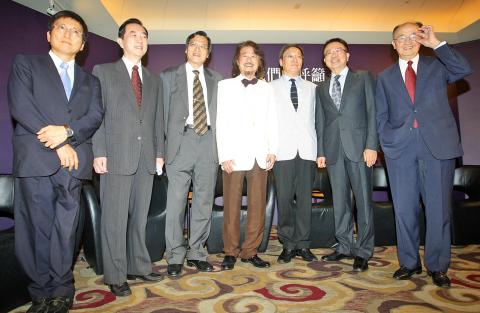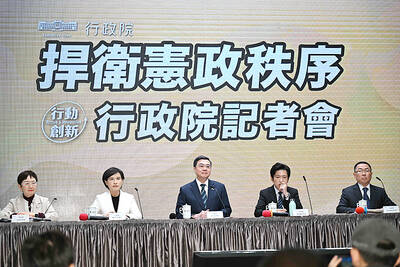Seven politicians and academics, headed by former Democratic Progressive Party (DPP) chairman Shih Ming-te (施明德), yesterday unveiled the “five principles” of a proposal, named the “broad one-China framework” (大一中原則), that they say could resolve the domestic political divide and stalemated cross-strait relations.
The group crosses party lines, and includes former Mainland Affairs Council chairman Chen Ming-tung (陳明通), who served under the DPP administration, and former National Security Council secretary-general Su Chi (蘇起), who served under President Ma Ying-jeou’s (馬英九) administration.
Shih said the five principles include “respecting the present ‘status quo’ and not changing it unilaterally,” adding that the “status quo” is that the Republic of China (ROC) and People’s Republic of China (PRC) have coexisted since 1949, with bilateral relations seeing a gradual transformation from “fighting with each other” to “governing separately.”

Photo: CNA
The “broad one-China framework” is aimed at establishing an international legal entity — consisting of the ROC and the PRC — for resolving issues through consensus, and serving as an interim scheme, Shih said.
The two sides under the framework should strive to eliminate hostility and work together to maintain peace and safety in the region, Shih said.
Both sides should promise not to use military force or sign any military agreement that is unfavorable to the other side, and both should be allowed to join international organizations, such as the UN, and establish normal state relations with other countries, he said.
“The five principles cannot be taken apart, they are like a set meal,” Shih said.
He said the initiative was inspired by the Chinese Civil War and Taiwan’s decades-long Martial Law era that for many years created deep hostility and divisions among the people, adding that political manipulations for election purposes have led to a great division between the pan-blue and pan-green camps to the point that they cannot communicate with the other.
Beijing’s “one country, two systems” or the “Hong Kong model” under its “one China principle” would not be accepted by Taiwanese, while neither the Chinese Nationalist Party’s (KMT) “one China with different interpretations” policy or the DPP’s “ROC equals Taiwan” proposal have found support, Shih said.
The civil war between the Chinese Communist Party (CCP) and KMT has led to animosity, but Taiwanese in general have no hatred toward China, so the PRC should try to understand why the Taiwanese cannot accept its claim of goodwill toward Taiwan, instead of believing that reconciliation with KMT means Beijing can take over the fate of the people of Taiwan, he said.
Su, a confidant of Ma, said that the Ma administration’s “three noes” — “no unification, no independence, no use of force”— is too passive, and could neither adapt to a changing environment nor solve future problems.
The nation’s challenges of the “big triangle” — the relations between the US, PRC and the ROC — and the “small triangle — the relations between the CCP, the KMT and the DPP — have become unstable, Su said.
Taiwan needs to initiate a creative scheme to create its own future, he said.
Responding to a question on whether the sovereignty of the PRC and the ROC under the proposed framework would be “separate” or “overlapping,” Su said that ambiguity could sometimes lead to better cross-strait relations.
“When things are explained clearer, the less flexible it is ... it would be troublesome if you only have two choices all the time … a certain amount of ambiguity is beautiful,” he said.
One of the most prominent China experts in the DPP, Chen said he thinks the five principles are a feasible compromise between the pan-blue and pan-green camps, but any proposition for improving cross-strait relations must be decided by the 23 million Taiwan ese through a national referendum.
The other five people behind the “broad one-China framework” are Tamkang University Graduate Institute of China Studies director Andy Chang (張五岳), former DPP legislator Hong Chi-chang (洪奇昌), former minister of foreign affairs Cheng Chien-jen (程建人) and former Straits Exchange Foundation vice chairman Chiao Jen-ho (焦仁和).
Hong and Chiao are both KMT members.
Shih, who was a political prisoner for more than 25 years under the former KMT administration, resigned from the DPP in 2000.
In 2006, he helped lead protests against the DPP government of former president Chen Shui-bian (陳水扁).

The US government has signed defense cooperation agreements with Japan and the Philippines to boost the deterrence capabilities of countries in the first island chain, a report by the National Security Bureau (NSB) showed. The main countries on the first island chain include the two nations and Taiwan. The bureau is to present the report at a meeting of the legislature’s Foreign Affairs and National Defense Committee tomorrow. The US military has deployed Typhon missile systems to Japan’s Yamaguchi Prefecture and Zambales province in the Philippines during their joint military exercises. It has also installed NMESIS anti-ship systems in Japan’s Okinawa

‘WIN-WIN’: The Philippines, and central and eastern European countries are important potential drone cooperation partners, Minister of Foreign Affairs Lin Chia-lung said Minister of Foreign Affairs Lin Chia-lung (林佳龍) in an interview published yesterday confirmed that there are joint ventures between Taiwan and Poland in the drone industry. Lin made the remark in an exclusive interview with the Chinese-language Liberty Times (the Taipei Times’ sister paper). The government-backed Taiwan Excellence Drone International Business Opportunities Alliance and the Polish Chamber of Unmanned Systems on Wednesday last week signed a memorandum of understanding in Poland to develop a “non-China” supply chain for drones and work together on key technologies. Asked if Taiwan prioritized Poland among central and eastern European countries in drone collaboration, Lin

NO CONFIDENCE MOTION? The premier said that being toppled by the legislature for defending the Constitution would be a democratic badge of honor for him Premier Cho Jung-tai (卓榮泰) yesterday announced that the Cabinet would not countersign the amendments to the local revenue-sharing law passed by the Legislative Yuan last month. Cho said the decision not to countersign the amendments to the Act Governing the Allocation of Government Revenues and Expenditures (財政收支劃分法) was made in accordance with the Constitution. “The decision aims to safeguard our Constitution,” he said. The Constitution stipulates the president shall, in accordance with law, promulgate laws and issue mandates with the countersignature of the head of the Executive Yuan, or with the countersignatures of both the head of the Executive Yuan and ministers or

CABINET APPROVAL: People seeking assisted reproduction must be assessed to determine whether they would be adequate parents, the planned changes say Proposed amendments to the Assisted Reproduction Act (人工生殖法) advanced yesterday by the Executive Yuan would grant married lesbian couples and single women access to legal assisted reproductive services. The proposed revisions are “based on the fundamental principle of respecting women’s reproductive autonomy,” Cabinet spokesperson Michelle Lee (李慧芝) quoted Vice Premier Cheng Li-chiun (鄭麗君), who presided over a Cabinet meeting earlier yesterday, as saying at the briefing. The draft amendment would be submitted to the legislature for review. The Ministry of Health and Welfare, which proposed the amendments, said that experts on children’s rights, gender equality, law and medicine attended cross-disciplinary meetings, adding that